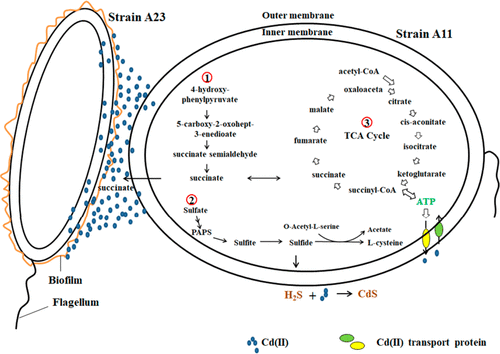Immobilization of Cd using mixed Enterobacter and Comamonas bacterial reagents in pot experiments with Brassica rapa L
Author:Xing Wang,Kang Hu,Qing Xu,Lingfei Lu,Shuijiao Liao, and Gejiao Wang
Environ Sci Technol. 2022 Dec 15. 54(24):15731-15741
Abstract: Enterobacter sp. A11 and Comamonas sp. A23 were isolated and identified. Coculturing these two strains with Cd(II) led to the production of biofilm, H2S, and succinic acid (SA), and Cd(II) was adsorbed by cells and formed CdS precipitates. After centrifugation, 97% Cd(II) was removed from the coculture. Proteomic and metabolomic analyses of the cocultured bacteria revealed that H2S and SA production pathways, metal transportation, and TCA cycle were active under Cd(II) stress. In vitro addition of SA enhanced the production of H2S and biofilm formation and Cd(II) adsorption. Two-season greenhouse pot experiments with Brassica rapa L. were performed with and without the coculture bacteria. Compared with the control, the average Cd amounts of the two-season pot experiments of the aboveground plants were decreased by 71.3%, 62.8%, and 38.6%, and the nonbioavailable and immobilized Cd in the soils were increased by 211.8%, 213.4%, and 116.7%, for low-, medium-, and high- Cd-spiked soils, respectively. The two strains survived well in soil during plant growth using plate counting, quantitative real-time PCR, and metagenomics analysis. Our results indicate that the combination of Enterobacter and Comamonas strains with the production of H2S and biofilm are important effectors for the highly efficient immobilization of Cd.
Full Article:https://doi.org/10.1021/acs.est.0c03114
